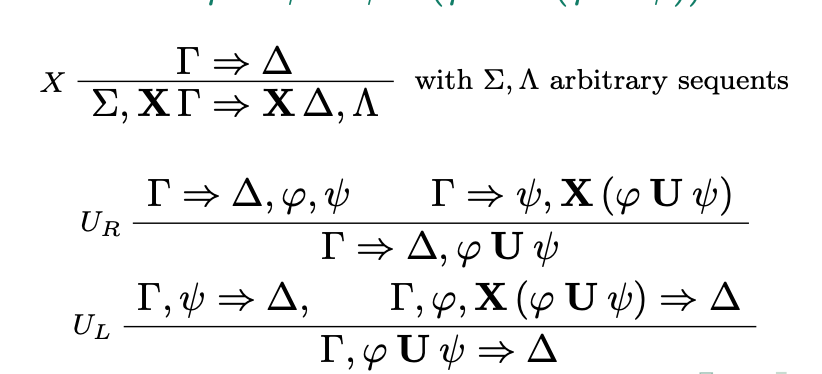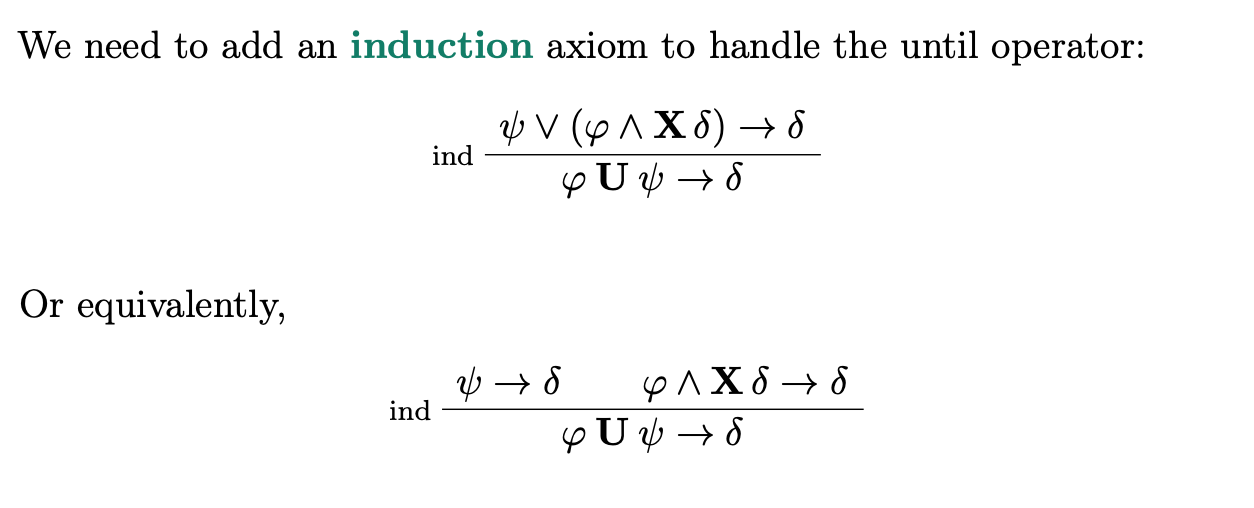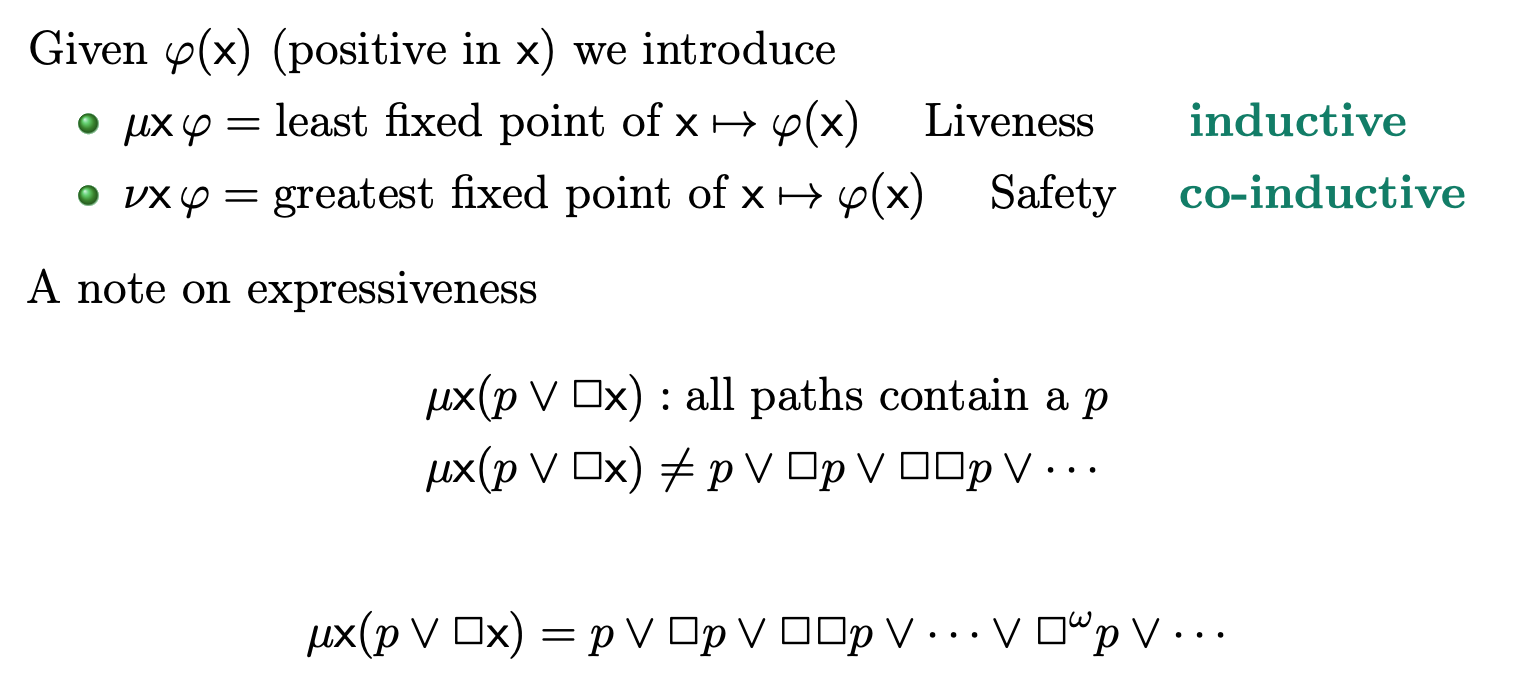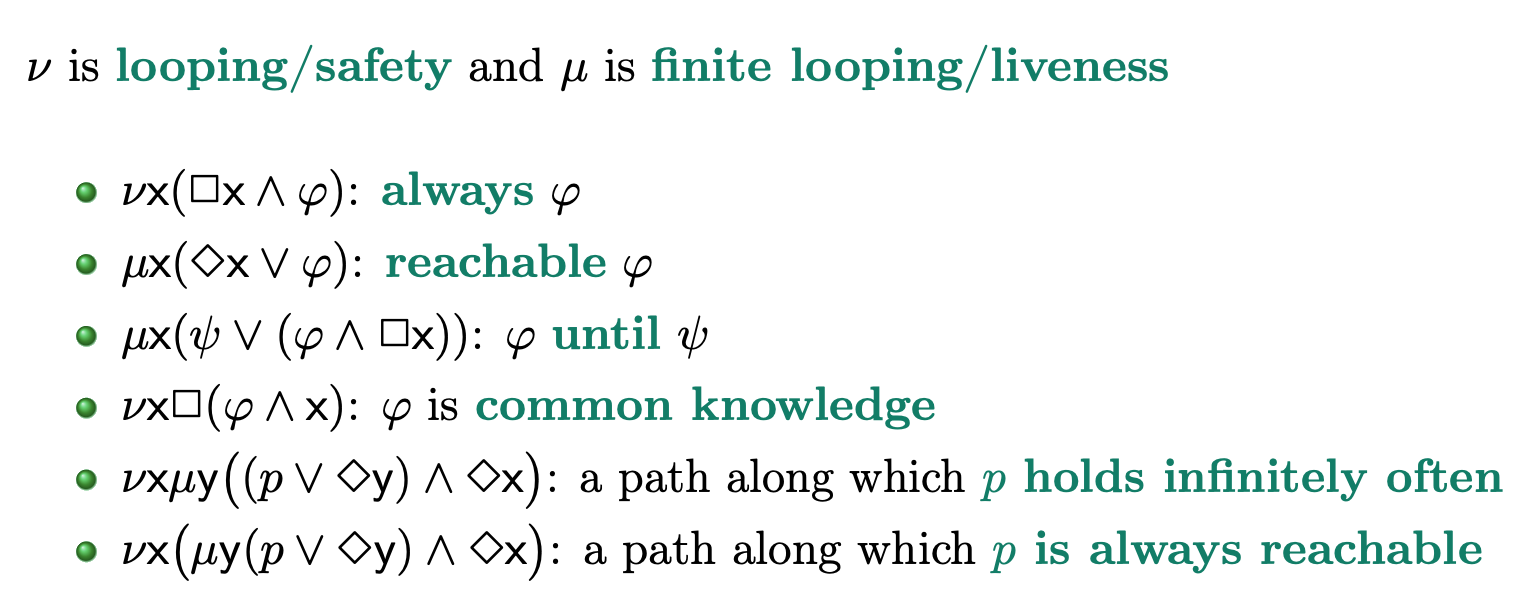References
Modal mu-calculus
Blue Book (Chapter 8) Temporal Logics in Computer Science:
The µ-calculus and Model Checking. Bradfield & Walukiewicz. Springer International Publishing, Cham (2018)
Recent survey
Green Book (Part V) Automata, Logics, and Infinite Games.
Selected proof, + history, good reference
Yellow Book (Chapter 6) Rudiments of µ-calculus. Arnold & Niwinski. Vol. 146. Elsevier (2001)
Abstract level
Proof Theory
Games for the µ-calculus. Niwinski & Walukiewicz. TCS 163(1&2):99-116 (1996)
On the Proof Theory of the Modal mu-Calculus. Studer. Studia Logica 89, 343-363 (2008)
Finitary Proof Systems for Kozen’s µ. Afshari and Leigh Oberwolfach Preprints. DOI 10.14760/OWP-2016-26 (2016)
Demystifying µ. Afshari et al. CoRR abs/2401.01096 (2024)
To find reference for other ppl’s work
Motivating example:
reactive systems Want to verify – Liveness Good things eventually happen – Safety Bad things never happen
permanent properties — requires fixpoint
Modal Logic
Syntax and Seantics
We are talking about multiple-world property (model may change / future … ) One can extend propositional logic by adding two unary predicates:
[]: box; necessarily<>diamond; possibly
Semantics: a transition systems with
-
states (a.k.a world)
-
relation
-
function interpreting atomic propositions
-
T, s |= [] Psiiff for everys -> twe haveT, t |= Psi -
T, s |= <> Psiiff for somes -> twe have `T, t |= Psi“
Satisfiability via tableaux
- construct negation normal form (not a restriction on expressive power) (negation on atomic
P’s)
Every formula of modal logic is equivalent to one in NNF. The equivalence is provable in K.
- Looking at the rules, look for consistent successors for each note,
- A tableau: a tree where each node is labelled by a subset of
Sub(Psi)
A tree is a special case of a Kripke structure
A path through tree t is a function P : N →S such that (currently P is not total, since path is in the tree)
A pre-tableau
The mod-rule can be applied only if no other rule is applicable
 The model of 1:
The model of 1: w0 ---> w1 (q)
The model of 2: w0 (neg p)
Each model rule go through, results in an extra node
Every formula of modal logic has at least one (and finitely many) pre-tableaux.
A tableau is a pre-tableau where the sequent (finite set of formulas) at each leaf has the form []Γ,Θ where Θ ⊆Lit is consistent.
Lemma (Soundness) If φ has a tableau then φ is satisfiable.
Visualization of the lemma: collapse the path separted by application of the mod-rules into the conditions into a Kripke structure.
Lemma (Completeness) If φ is satisfiable then φ has a tableau.
Proof idea: satisfiable => T, s0 |= Psi,
- Use the model T as a guiding tool to construct a tableau for φ.
- We can argue that we can create a tableau
Corollary
- Modal logic has the finite model property.
- Decidable
Linear Time Temporal Logic
Modal language: a formula fixed the length of path of a model. e.g.
<>^100 P
We need path quantification
-
X \phi, next, same as modal logic -
\phi U \psi:\phiholds until\psibecomes true -
F \phi: eventually true- true at some point in the future
F \phi = true U \phi
-
G \phi: always true- (at every point in the future, including present)
G \phi = !F !\phi
Other examples:
-
Recurrence: “p1 holds infinitely often”
- G (F p1)
-
Request-response: “It is always the case that whenever p1 holds, p2 will hold sometime later”
G (p1 -> X F p2)
-
Fairness: “If p1 is true infinitely often, then so is p2
- `G F p1 →G F p2
Semantics
check see slide
Linear vs Branching
LTL Proof Systems:
-
in two-sided sequent calculus so we can handle negation.
-
φ U ψ ≡ ψ ∨ ( φ ∧ X (φ U ψ))- unraveling once, -
==
ψ ∨ φandψ ∨ X (φ U ψ) -

- X: modality rule for next operator (recall modal logic)
- UR and UL are just exploiting the unraveling equivalence
- UR, applying the distr+unraveling
- UL, applying the unraveling
Two sided sequent calculus (for satisfiability)
gamma_1, ... , gamma_n |- delta_1, ... , delta_mmeans/\ gamma_i implies \/ delta_j
One sided: When reading as satisfiablity, we interpret comma as conjunction When reading as validity, we interpret comma as disjunction
The complexity of UR premise becomes larger =⇒ Infinite branches
Non-wellfounded Proofs
Proofhood condition every infinite path carries an infinite trace that passes through UL with the until formula principal.

Hilbert’s LTL finitary axiomatisation (for comparison)

Cyclic and Ill-founded Proofs
For modal logic K4, we cannot derive Löb’s axiom: []([]p -> p) -> []p.
 something we cannot do wihout Lob axiom
something we cannot do wihout Lob axiom
Definition for cyclic:
- on each cycle progress is made
- For modal logic,
<>rule is used
- For modal logic,
- idea behind: the more general “principle of infinite decent”
Modal mu-calculus
Modal logic - revisited
- syntax
- semantics: denotations of formula: all the states that satisfy
- Expressive limitation: properties along arbitrary (finite or infinite) paths in a structure cannot be presented
- No infinite disjunctions like:
<>1 p \/ <>2 p \/ ....(reachable)
- No infinite disjunctions like:
Observation: they are just fixpoints of a function :
x |-> p \/ <> x

Modal mu-calculus
- syntax: add variable,
muandnuquantifiers We can express many modal operators using fixpoints
- fixpoints back to back: infinitely often …
- p is always reachable:
mu y. (p \/ <> y)is independently evaluated, weakly binded, sopmight not necessarily be on the particular path
- p is always reachable:
Hierarchies in mu-calculus
fixpoints back to back
#idea nested recursion
Connexion:
- LTL can be captured by µ-calculus formulas of depth 2
- why the extra depth? (exercise)
- we have until, next
- why the extra depth? (exercise)
- CTL, PDL can be captured by alternation-free µ-calculus
- CTL*: depth 3
Connection (good properties)
- Expressive: LTL, PDL, CTL, CTL*
- Robustly decidability: model checking, satisfiability
- Closed under bisimulation — but logic is not compact.
- Equivalent to: alternating parity automata, parity games
automata (see Green block) simplify proofs and give more results
Tree Model Property: every satisfiable formula has a tree model.
Finite Model Property: every satisfiable formula has a finite model
Proof systems
Kozen’s axiomatization
neg(Psi) ----> Phi(neg(Psi))
-----------------
neg(Psi) ----> Nu x. Phi
leads to the (ind) axiom
modal mu-calculus revisited
we want to throw away the (ind) rule
using the ideas of tableaux …
The introduced rule (mu) and (nu) can form a derivation with direct correspondence to the traces
Result: For every infinite trace there exists a formula σxφ that appears infinitely often and is the shortest formula occurring infinitely often. ⇒ We call “most significant formula”